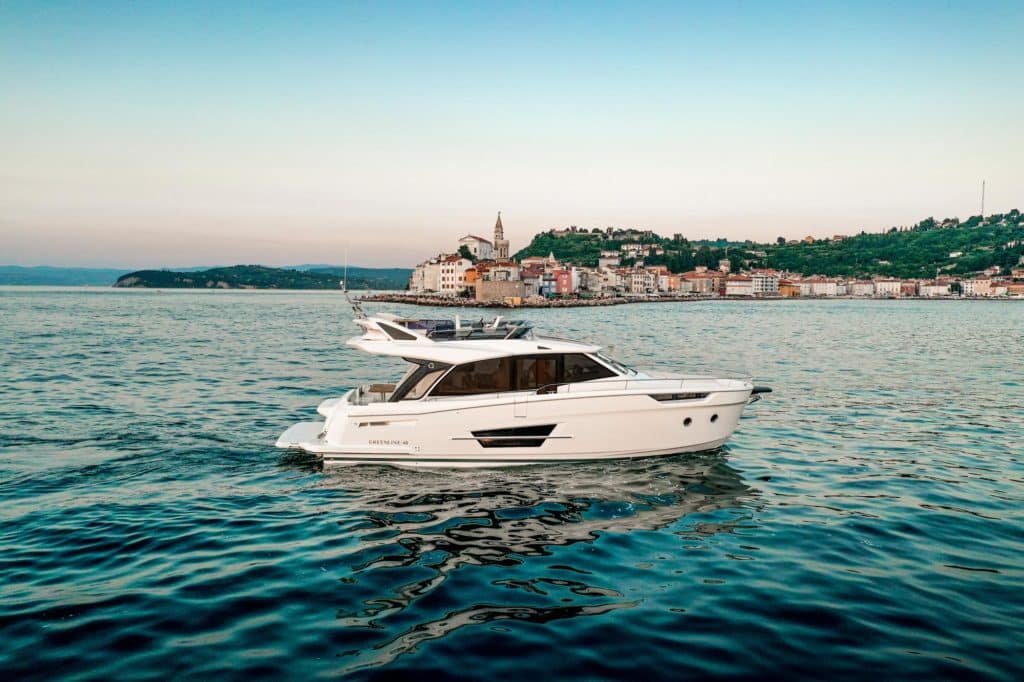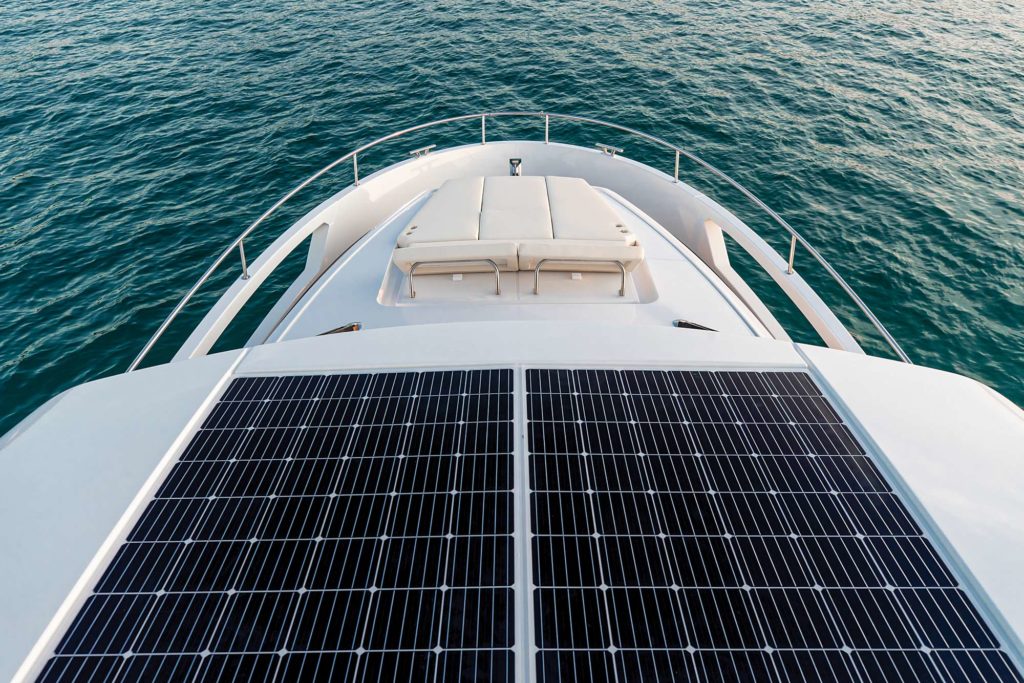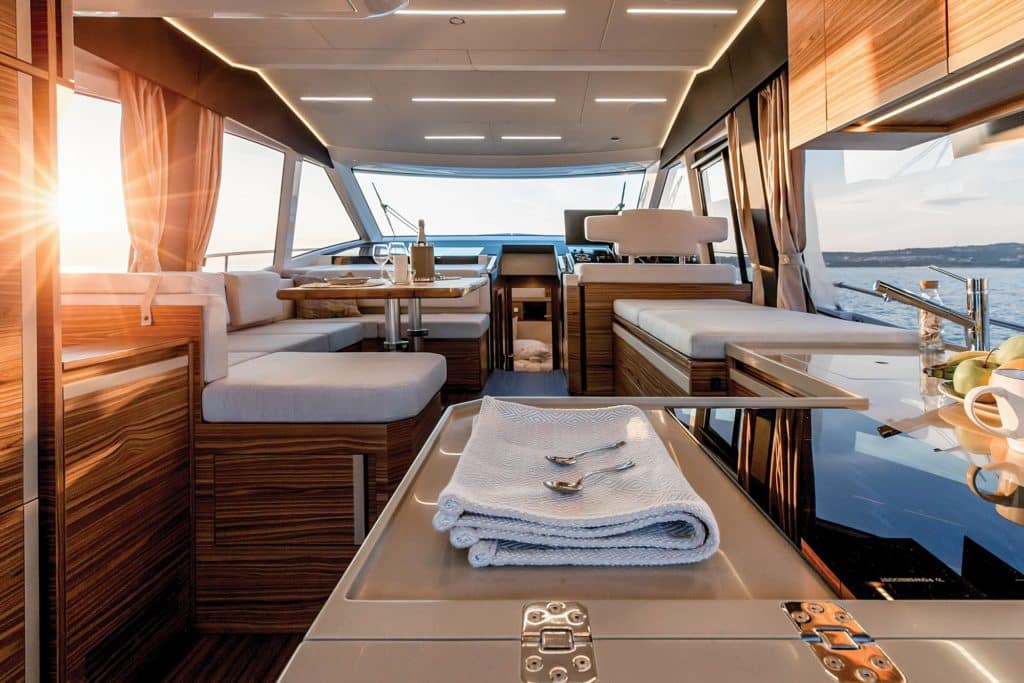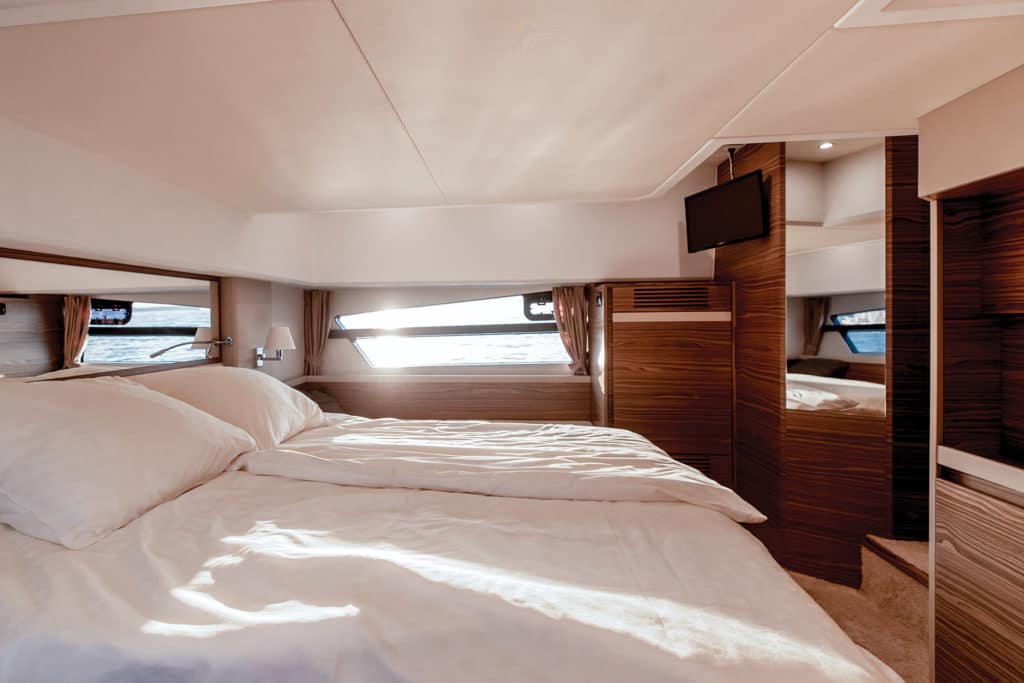
Kermit the Frog famously said, “It’s not easy being green,” but Greenline Yachts has a reputation for building environmentally friendly electric- and hybrid-drive yachts. And while the diesel-powered Greenline 45 Fly may seem to be a step back toward fossil fuels, it’s not. Here’s why.
Some North American buyers—I’m not pointing any fingers, but you know who you are—want more oomph than an electric/hybrid power package can offer. The Greenline 45 Fly offers twin Volvo Penta IPS pod-drive diesels (or shaft-drive Yanmars) for skippers who want some giddyap.
But having those diesels doesn’t mean owners give up eco-friendly features. Every Greenline comes with solar panels, a 7.2 kWh lithium-polymer battery and a 3 kW inverter for AC power. Tech talk is fine, but many skippers ask: “What’s in it for me?” Imagine having 120-volt AC power at anchor without running a generator. On a summer weekend, owners can power everything from the fridge to air conditioning to the blender for up to three days without a generator. No noise, just soundless energy—well, except for the blender making margaritas. Cloudy weekend? Kick on an engine to recharge the battery during day two. Opt for the fiberglass hardtop with solar panels on the top, and owners can stretch those quiet weekends even longer.
The Greenline E-Drive is pure electric. With batteries topped off at the marina, the yacht has a top speed of about 8 knots and a range of 40 nautical miles. Others may choose the Greenline H-Drive, with twin shaft-drive diesels starting at twin 220 hp and going up to 435 hp diesels with pods. The H-Drive 45 Fly can cruise under electric power at 6.5 knots with a range of 30 nautical miles. This gets you in and out of anchorages silently or allows a harbor cruise sans engine noise.

To keep power requirements to a minimum, Greenline designed a slippery hull form it calls the superdisplacement, which emulates those seen on sailing yachts to minimize drag. The boat I got aboard had twin 435 hp IPS600s that propelled the 45 Fly to a solid 30 knots. The boat came easily onto plane.
What surprised me, however, was that the wake was table flat. The 45 Fly was slipping through the water gracefully. And when we did take our lumps from buckets of wind in a choppy Gulf Stream, the boat had an easy, dry motion, parting the waves rather than trying to crush them. I registered just 70 decibels at 18 knots, making conversation exceptionally audible in the salon.
The builder also does a fine job with layouts and fit and finish. The 45 Fly, for example, has two airy staterooms, each with a walk-in closet—that owners can actually step into and close the door. There is 6-foot-5-inch headroom in the master stateroom and 6-foot-7-inch headroom in the master shower. The master also has a king berth with walk-around space, so no crawling into bed. The hullside windows are positioned so owners can enjoy the view while nestled under the covers.

Forward, the VIP stateroom has 6-foot-6-inch headroom, along with a queen-size walk-around berth and a walk-in closet. The boat we got aboard also had a washer/dryer here. This stateroom is bathed in light from five clerestory windows at deck level that give a view of sky from bed. And two opening ports are on each side at berth level.
I mentioned harbor cruises, and the 45 Fly lends itself to entertaining. The four-panel sliding doors fold away, opening the galley to the cockpit. A flip-down panel, which also serves as a backsplash with the salon doors closed, becomes an outdoor bar for the cockpit.
The overhead in the salon has 6-foot-6-inch headroom at the lowest point, adding to the sense of volume that the side windows impart. I particularly liked the walk-through door next to the helm seat. It’s by a deck cleat, so shorthanded skippers can get a line to the dock and still reach through the door to the pod’s joystick to keep the yacht placed.

The dinette in the salon converts to a double berth to handle guests or kids, but if owners absolutely must have a third stateroom, they can opt to trade the walk-in closets for a single-berth stateroom.
The bridge is pushed well aft to make room for solar panels, and it’s arranged for entertaining with a dining settee and mini galley console. The helm mirrors the lower station, and a sun pad fills the remaining space. A foldout grill and sink are at the transom, where there’s also a garage to stash fenders, Seabobs and deck gear.
Owners will have some decisions to make when it comes to propulsion, but whatever the choice, the Greenline 45 Fly has a lot to offer. Sometimes, it’s actually easy to be green.
Take the next step: greenlinehybrid.com








